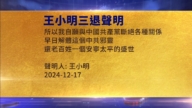【新唐人2014年11月24日讯】日前,国际评级机构:标准普尔对中国的房地产、地方政府、银行等多个领域进行了评级,结果地方政府半数被评为“垃圾级”。专家指出,标准普尔的评估来源于中共公布的数据,由于这些数据水分很大,因此实际现状应该更差,不过这些评级结果已经足以让国际机构加快撤资、逃离中国。
国际评级机构标准普尔(S&P)11月20号发布一份报告,对中国多方面经济进行了评估。根据标准普尔的说法,中国大约一半的地方政府应授予“垃圾级”的信用评级,而中国企业信贷状况出现分化,银行业的经济风险也比较高,尤其对中国房价过高,楼市供应过剩提出了警告。
美国南卡罗莱纳大学艾肯商学院终身教授谢田:“一两年前我们都指出过,这些问题现在不光是越来越明朗化,也越来越被西方的评级机构和金融业所认识到,认识到这些问题之后,下一步动作,一个做空,一个撤资会越来越加剧。”
在对中国地方政府的评级中,标准普尔的分析暗示,31个被调查的中国地方政府中,15个应评为“垃圾级”,尤其东北的表现最差,东北三个省份中有两个出现了“投机级信用特征”。而中西部省份中,近半数出现了垃圾债券特征。
清华大学经济学教授杨斌:“甚至一半还多,因为有很多假象,还高估了。”
据大陆媒体报导,此前中共已经采取切割政府债务和企业债务的方式,将至少14万亿政府债务转为企业债务,并且正在筹划,将这些债务证券化,上市兜售。
《金融时报》评论指出,标准普尔的评级,可能会对中共中央政府发展市政债券市场的努力,造成打击。
谢田:“实际上也都是垃圾债券,但是肯定它还会继续发,中国的老百姓可能还会继续买,因为中国也搞了一些自己虚假的评级机构,它会给它非常好的评级来欺骗中国的百姓,而中国百姓可能还有另外一个侥幸心理,觉得中共在掌权,它不会让这些地方债违约或破产。”
而标准普尔的一份名为《银行业国家风险评估:中国》的报告中说,中国较低的人均GDP限制了经济发展的弹性。
杨斌:“80%的人消费比较低,收入比较低,更严重的限制了中国的弹性,80%的人平均储蓄不到一万元,怎么去拉动消费,还没有社保,他不敢花,一生产就过剩,一生产就过剩嘛,循环不起来。”
报告中还说,中国银行业的经济风险也比较高,而信贷的快速扩张又带来了经济失衡的高风险,以及经济中较高的信贷风险。
杨斌:“作为银行来说没什么风险,作为老百姓来说风险比较大,通货膨胀比较厉害,严重的时候,投资回报还抵不上通货膨胀。”
在行业风险方面,标准普尔认为,银行业普遍的国有产权,以及对存款利率的行政控制,阻碍了银行业的动态竞争。
谢田:“不光垄断了利率,实际上用这个办法在压低利率,也在压低汇率,通过各种方法来盘剥中国老百姓,让老百姓不得不把钱存在中共国有银行里边,不得不让他们的存款大幅度的缩水。”
另外,标准普尔的评级结果显示,虽然中国企业信贷状况恶化的程度有所减轻,但企业间的竞争,和产能过剩是一个很大的难题。而企业的债务主要集中在铁路、地铁和公共事业,这些行业又与政府的政策息息相关。
同时标准普尔还对中国的房地产业发出了警告,报告称中国房地产市场评级,可能比亚洲其他大型市场受到的冲击更大。而房地产市场定价过高,加上供应过剩,预计中国和香港的房价面临下滑。
由于房地产业,占中国年度经济产出的比重超过15%,而银行业为建房和购房提供大量融资,房地产市场长期低迷,反过来又是中国经济面临的最大风险。
采访编辑/刘惠
S&P Finds Half of Communist Local Governments
Deserve Junk Ratings.
New analysis on China by Standard & Poor’s (S&P) saw low
performance in real estate, local governments, banks etc..
Half of the local governments may warrant
junk-level credit ratings.
Experts indicate the actual situation will be worse since the
analysis was based on data alleged by local governments.
However, this rating is sufficient to have international
agencies short China, accelerate the divestment and flee.
The S&P analysis of China credit on Nov. 20 suggested about
half of China’s local governments deserve junk-level ratings.
According to a FT report, warnings are suggested over the
diverging credit profiles in the corporate sector.
This is amid the high risks in the banking
and real estate bubbles.
Professor Frank Xie, University of South Carolina Aiken
School of Business, “We pointed this out two years ago.
It is now becoming more clear and recognizable by the
Western analytical agencies and financial sectors.
Their next step will be to short China
and increase divestment."
The S&P analysis found 15 of the 31 localities surveyed to
be worthy of junk status.
Northeast China fared the worst in the analysis.
Two of the three provinces in Northeast China had what it
called “speculative-grade credit features."
Half of the Midwest provinces deserved “junk" ratings.
Yang Bin, economics professor at Tsinghua University, “It
should be more than half, since many were covered up
by illusion. It is overrated."
According to mainland media reports, the regime has
separated local government debts from corporate debts.
At least 14 trillion yuan of government debts have been
transitioned into corporate debts.
These debts will be peddled through issuing of securities.
According to the FT, S&P bashes China’s local-governmental
effort in developing the municipal bond market.
Professor Frank Xie, “The bonds must be junk as well.
Under the false rating from the Chinese agencies, Chinese
people are likely to be deceived and buy those bonds.
The people might be willing to take chances believing that
under the ruling of the Chinese Communist Party (CCP),
no default or bankruptcy would happen."
In the report titled, Banking Industry Country Risk
Assessment: China, S&P stated that the country’s
low per capita GDP constrains its economic resilience.
Yang Bin, “The flexibility of China is very seriously limited
by 80% of the population having a relatively low
consumption rate and low income.
With less than 10,000 yuan of average savings (about
US$1,631) and no social security for 80% of the population,
how can the consumption be stimulated? They would not
dare to spend the money.
Any production will only result in surplus. It is a cycle."
S&P also said in the report, rapid credit expansion has led to
high risks of economic imbalances and elevated credit risks
in the economy.
Yang Bin,"There is not much risk to banks, but relatively high
risk to the ordinary people.
When inflation is severe, the return on investment
can’t make up the difference from inflation."
In terms of industry risk, prevalent state ownership and
administrative control of deposit rates challenge the banking
sector’s competitive dynamics, reported the S&P.
Frank Xie, “It is not just the interest rate, in fact,
it lowers the interest rates and the exchange rates.
Through various exploitations, the Chinese have to save
the money in the state owned banks and tolerate the
huge depreciation of their deposits."
S&P’s ratings also showed that, the credit deterioration
of Chinese enterprises may been reduced, but competition
between enterprises and overcapacity are major problems.
The enterprise debts have focused on rail, subway and public
utilities, the ones closely linked with the government’s policy.
S&P also warned in the property report, China’s over-priced
and over-supplied property market are likely to result in
Chinese and Hong Kong house prices falling in coming years.
Reuters reported, the property sector accounts for more
than 15 percent of China’s annual economic output;
Banks provide much of the financing for building and buying,
so a prolonged downturn poses possibly the biggest risk
to the world’s second-largest economy.
Interview & Edit/LiuHui




























